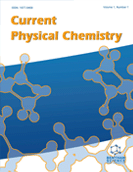Abstract
Background: Additions of water monomer (H2O) to simplest ketene, i.e., H2C=C=O (mentioned as ketene, henceforth) in the Earth's atmosphere results in the formation of acetic acid. However, this reaction is not feasible under tropospheric conditions due to the high reaction barrier amounting to nearly 40 kcal mol-1. A Significant reduction of the barrier height (below 20 kcal mol-1) is achieved upon addition of another H2O molecule as a catalyst. It is worth mentioning that like H2O and ammonia (NH3), H2S could also play an important role in the “loss mechanism” of various atmospherically important species such as ketones and aldehydes.
Aims: This study aims to get insight into the energetics and kinetics of a reaction between ketene and H2S in the troposphere which has not been done before.
Objective: Due to close similarity of H2O and H2S, studying the sulfolysis reaction between ketene and H2S could provide some interesting insights into the nature of various hydrogen bonded complexes of ketene as well as the impact on the products formed under the atmospheric conditions.
Methods: The water and ammonia catalyzed gas-phase addition reactions of ketene with H2S has been investigated using CCSD(T)-F12a/cc-pVTZ-F12a//M06-2X/6-311++G** level of theory. In this study, rate constants for all possible reaction channels are calculated using transition state theory.
Results: It is found that, under tropospheric conditions at 298 K and 1 atm, the rates via catalyzed reaction channels are significantly faster than those via uncatalyzed reactions. Between the two catalysts, ammonia acts as far better catalyst than water for this reaction. However, since the concentration of water is significantly larger than ammonia, the effective rate of water catalyzed reaction becomes higher than that of ammonia catalyzed reaction. Combustion is a major source of ketene in atmosphere. Under combustion conditions such as in the presence of air and at or above ignition temperature, the ammonia catalyzed channel is faster below 1500 K, while the uncatalyzed reaction channel becomes faster above that temperature.
Conclusion: Results from the present study show that the barrier for thioacetic acid formation through uncatalyzed sulfolysis of ketene via faster C=O addition pathway is substantially high as 40.6 kcal mol-1. The barrier height of the two transition states TS1 and TS2 are 19.7 and 13.8 kcal mol-1 for water catalyzed reaction and 14.4 and 7.2 kcal mol-1 for ammonia catalyzed reaction. Thus, ammonia has appreciably lowered the barrier height compared to water as catalyst. It has been observed that the hydrolysis reaction is more probable than the sulfolysis reaction under atmospheric conditions in the troposphere, but the ammonia catalysed sulfolysis is the fastest one at 298 K. The effective rate constant of the water catalysed hydrolysis reaction is found to be more than the ammonia catalysed reaction due to the higher monomer concentration of water than ammonia. Ammonia catalyzed reaction rate increases monotonously with increasing temperature. Further rate coefficient for uncatalyzed reaction is found to be dominant under combustion conditions, i.e., above 1500 K.
Graphical Abstract
[http://dx.doi.org/10.1086/587734]
[http://dx.doi.org/10.1021/jp903401h] [PMID: 19719311]
[http://dx.doi.org/10.1021/jp993537b]
[http://dx.doi.org/10.1016/j.combustflame.2010.12.022] [PMID: 23814311]
[http://dx.doi.org/10.1021/ef300336y]
[http://dx.doi.org/10.1021/ja01157a084]
[http://dx.doi.org/10.1021/ja01121a020]
[http://dx.doi.org/10.1021/ja00996a001]
[http://dx.doi.org/10.1021/jp408337y] [PMID: 24087932]
[http://dx.doi.org/10.1021/jp5076725] [PMID: 25590617]
[http://dx.doi.org/10.1039/C8CP01650J] [PMID: 29722396]
[http://dx.doi.org/10.1039/C8CP05276J] [PMID: 30303213]
[http://dx.doi.org/10.1021/acs.jpca.6b12303] [PMID: 28067517]
[http://dx.doi.org/10.1021/acs.jpca.7b09563] [PMID: 29112437]
[http://dx.doi.org/10.1002/anie.201604848] [PMID: 27678012]
[http://dx.doi.org/10.1016/j.cplett.2009.01.070]
[http://dx.doi.org/10.1021/jp022291z]
[http://dx.doi.org/10.1039/ft9949003051]
[http://dx.doi.org/10.1021/j100267a036] [PMID: 11542011]
[http://dx.doi.org/10.1016/0004-6981(69)90023-7] [PMID: 5382203]
[http://dx.doi.org/10.1080/17415990412331317919]
[http://dx.doi.org/10.1038/srep29883] [PMID: 27443234]
[http://dx.doi.org/10.1016/S0166-1280(00)00515-7]
[http://dx.doi.org/10.1080/0144235X.2011.634128]
[http://dx.doi.org/10.1002/cphc.200400405] [PMID: 15799459]
[http://dx.doi.org/10.1016/S1464-1917(01)00034-4]
[http://dx.doi.org/10.1080/0144235031000075780]
[http://dx.doi.org/10.1063/1.3608919] [PMID: 21766916]
[http://dx.doi.org/10.1039/c1cp20872a] [PMID: 21687896]
[http://dx.doi.org/10.1021/acs.jpca.7b09889] [PMID: 29212320]
[http://dx.doi.org/10.1039/C7CP05475K] [PMID: 28991295]
[http://dx.doi.org/10.1002/wcms.81]
[http://dx.doi.org/10.1021/acs.jpca.8b09306] [PMID: 30901223]
[http://dx.doi.org/10.1016/j.comptc.2020.112747]
[http://dx.doi.org/10.1016/j.atmosenv.2019.03.025]
[http://dx.doi.org/10.1063/1.459618]
[http://dx.doi.org/10.1002/(SICI)1096-987X(19980715)19:9<1039:AID-JCC5>3.0.CO;2-R]
[http://dx.doi.org/10.1039/C6CP04544H] [PMID: 27711502]
[http://dx.doi.org/10.1021/acs.jpca.7b01172] [PMID: 28368597]
[http://dx.doi.org/10.1016/j.comptc.2018.04.005]
[http://dx.doi.org/10.1016/j.atmosenv.2019.05.069]
[http://dx.doi.org/10.1039/C9CP01720H] [PMID: 31298235]
[http://dx.doi.org/10.1029/1999GL900028]
[http://dx.doi.org/10.1021/acs.jpclett.5b01109] [PMID: 26266852]
[http://dx.doi.org/10.1021/acs.jpca.9b00672] [PMID: 30681339]
[http://dx.doi.org/10.1021/jp407282c] [PMID: 24028451]
[http://dx.doi.org/10.3155/1047-3289.60.2.210] [PMID: 20222534]
















